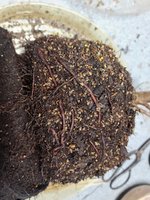Soooo, that fabric is garbage for what you would like to accomplish on a bonsai tree. It will definitely work for air-pruning, but it will not last with sunlight, as it is designed to be covered by something ie. mulch, gravel, etc... I used to fold them as well, but what I have been doing now is cutting the grow bags I use for in-ground trees height in 1/2, I have all the pieces saved and I plan on making rounds and ovals out of plywood or some kind of plastic to use as the bottoms and attached the bag sides to them.
A much better option is the Root Maker fabric, as it also prunes by pinching the root tip instead of air pruning, and this one has a vinyl coating on the outside that helps keep moisture in. Its $90 for a 36"x10 yards piece, enough for a bunch of sides. I have one of this at home and will be making a bunch of "grow pots" for the air-layers that will be removed (hopefully) this fall.
36" Tall X 10 yards When installed in a trench, this unique fabric traps root tips and works as a root barrier in landscaping. Provides maximum protection against root escape while allowing the production of new roots in the zone of loosened soil. Install with the fuzzy side toward the roots to...
myrootmaker.com


